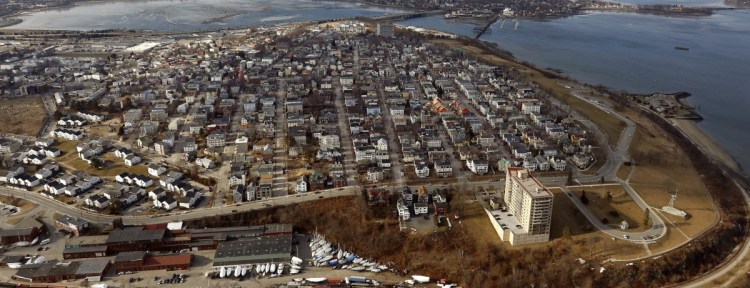About two-thirds of the buildings on Munjoy Hill have architectural details and character that could contribute to a local historic district, a Greater Portland Landmarks study has found.
However, high demand for real estate is rapidly changing the neighborhood, with affordable housing and historic buildings being torn down and replaced by contemporary, high-end condominiums that residents say are out of scale and out of character.
The Portland City Council approved a moratorium on building demolitions in December, but the long-term future of the neighborhood is still uncertain.
On Monday, the city will hold the first in a series of forums billed as listening sessions to gather public input about historic preservation and future development. It starts at 7 p.m. at the East End School.
The competing pressures on the hill are sure to fuel much debate, and neighbors who want to preserve its historic character have been organizing to resist those who want to open the door to more redevelopment.
Greater Portland Landmarks presented its research to Portland’s Historic Preservation Board last week, but hasn’t taken a public position on whether to create a historic preservation district in the neighborhood.
“We really want to give this information to the neighborhood,” said Julie Larry, the director of advocacy at Greater Portland Landmarks. “It really will come down to what the neighborhood wants to see for their community.”
Munjoy Hill is at the heart of a historic rental housing market that pushed Portland’s vacancy rate to virtually zero. Once considered a poor neighborhood, it is now home to multimillion-dollar condos. In 2015, the City Council changed the zoning rules in the area to make it easier to build on small lots, in hopes of encouraging more housing development. As residents began to call for a moratorium, the city’s planning staff was already reviewing those changes to measure their impact.
“Some of it is working really well,” Senior Planner Christine Grimando told the Historic Preservation Board last Wednesday. “Some of it is more traditional than others. Some of the contemporary stuff is good, and some of it is problematic.”
In December, the City Council also blocked new site plan applications for 65 days. Applications already in progress with the city were allowed to move forward. When that period ended, the City Council enacted a temporary set of standards for new site plan applications. Called an “interim planning overlay district,” these standards will be in place until June, when the moratorium also expires. They may or may not be incorporated in the long-term plan for development on the hill, but they address some of the concerns already broached by residents.
For example, the temporary standards require traditional roof styles like a side gable for single-family homes and duplexes. They do not allow modern, flat styles that have been common among new condo buildings. The standards also require the first floor to include active living space.
“We’re seeing a lot of parking taking up the front facade in one form or another,” Grimando said. “We’re seeing this as one area we really need to address. These patterns don’t necessarily add to the streetscape and are giving us some awkward designs.”
Grimando said the planning staff is still considering a number of tools, ranging from stricter design standards to a review process for demolitions. It plans to bring a proposal for long-term changes to the Planning Board in April and the City Council in May.
One option could be to designate parts of Munjoy Hill as a historic district, which would require approval from the City Council. That designation does not prevent development, but it limits the type of development allowed and increases the scrutiny during the planning and application process. Among the requirements for a historic district are that a substantial number of properties have a high degree of cultural, historic or architectural significance and integrity.
The Greater Portland Landmarks survey was a visual assessment that did not delve into structural integrity or historical significance. But based on the construction history on Munjoy Hill, the group determined a high number of properties remain that could contribute to a historic district. Of roughly 750 properties with buildings on Munjoy Hill, the survey found more than 500 had moderate to very high architectural integrity.
Larry described the buildings on Munjoy Hill as diverse. The neighborhood includes a range of historic building styles from the 19th and 20th centuries – Greek Revival and Italianate homes for railroad workers, small-scale farmhouses, triple-decker apartments for waterfront workers and immigrants, large Queen and Colonial Revival homes on the Eastern Promenade.
“Whether there is a historic district on the hill or not, thinking about context, I think it is important to remember that there are large-scale buildings on the hill next to very small-scale buildings on the hill,” Larry said. “That’s part of the eclectic nature because of the way the hill developed.”
Deb Andrews, the city’s historic preservation program manager, said the city wants input from neighbors and developers alike during this review.
“You have to consider an interest in allowing increased density,” Andrews said. “There’s an interest in that on the part of the City Council and just as a general policy. There’s also building conservation. How do we deal with issues like demolition?
“Balancing all of that is a bit of a trick.”
The second listening session will be at the East End School on March 24 at 11 a.m.
Twitter: megan_e_doyle`
Correction: The photo caption was revised at 8:21 a.m., Feb. 26, 2018, to reflect that the tower in the foreground of the photo is the Portland House condominiums and apartments. A previous version of this story misidentified it.
Send questions/comments to the editors.




Comments are no longer available on this story